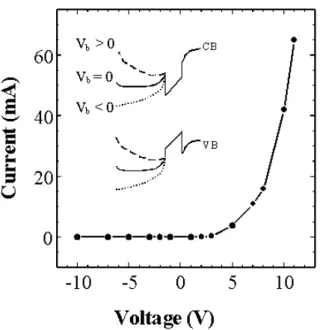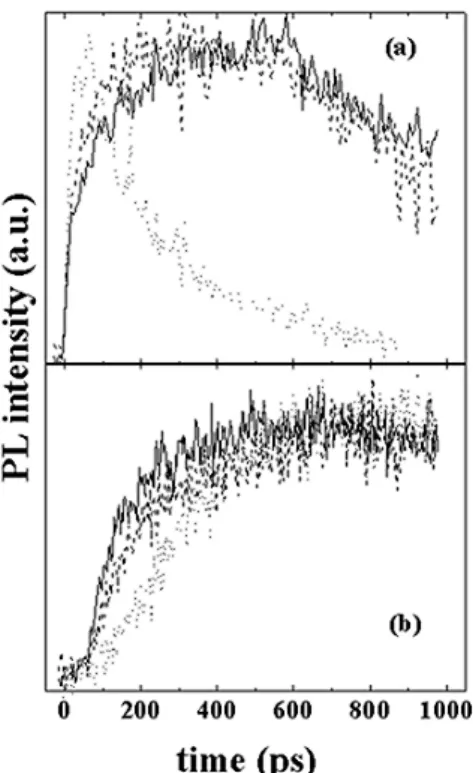Carrier Dynamis Investigated by
Time Resolved Optial Spetrosopy
SaulJ. Luyo 1
,Maria S.P. Brasil 1
, HugoB. de Carvalho 1
,
Wilson de Carvalho Jr. 2
,and Ayrton A. Bernussi 2
1
UniversidadeEstadual deCampinas, IFGW,Campinas,SP, Brazil
2
LaboratorioNaionaldeLuzSnroton,Campinas, SP,Brazil
Reeivedon23April,2001
We have investigated the transportof arriers inGaAs usingtime resolved optial spetrosopy
withpioseond resolution. Carriers are optiallyreated to the samplesurfae by anultra-fast
laser pulse. They diuse and drift throught a thik GaAs layer, untilthey are aptured by an
InGaAs quantumwell, where they reombine with holes from a p-type doped layer at aninner
InGaPbarrier. OurstudywasperformedwithasetofsampleswithdierentGaAslayerthikness.
AstheGaAsthiknessinreases,theemissionfromthequantumwellisdelayedanditsdeayslows
downsigniantly. WehaveinvestigatedtheeetofanappliedDCeldbetweenthesurfaeand
the InGaAsquantumwell. Thetransient of thequantumwellemissionis mostlyindependentof
theappliedDCvoltageuptoeld oftheorderof20KV/m,inludingbothpolarities. Thisisa
learindiationthatthearriertransportisdominatedbyambipolardiusionduetotheCoulomb
interationthatstronglyouplesphotoinjetedeletronsandholes. Ontheotherhand,thedeayof
theGaAsemissionvariessigniantlywhenaDCgatevoltageisappliedsuhasaurrentappears
atthestruture.
I Introdution
A large amountof experimental and theoretial work
has aumulated on arrier transport in
semiondu-tors over the last deades[1℄. This researh remains
howeverfundamentalforthedevelopmentofhigh-speed
eletroni and optoeletroni devies. An espeially
interesting point is the investigation of arriers
trans-portwhentheyarefarwayfromequilibriumonditions.
Carrier transport proesseshave been shown to aet
greatlymany ofthe statiand dynamis propertiesof
quantum well(QW) lasers[2℄. Timeresolved
lumines-enespetrosopyhasprovidedimportantinsightinto
thedynamialbehaviorofmanyphysialsystems.
II Experimental details
Oursamplesweregrownbymetal-organihemial
va-pordeposition (MOCVD) epitaxy. Thestruture
on-sistedofatopGaAslayer,a50
AInGaAsquantumwell
(QW), a thin InGaP intrinsi layer, whih ats as a
spae layer,followed by ap-dopedInGaP layerand a
p-doped GaAs buer layer, on top of the GaAs
sub-strate. An external eletrial eld may be applied to
the struture througha semitransparentAu Shottky
ontatonthe GaAs surfaeand anohmi ontatat
plesweregrownwithidentialonditionsanddierent
thiknessof thetopGaAs layer: 100
A, 1m and 4.5
m. Time-resolvedphotoluminesene (PL)datawere
obtainedusing an up-onversion system. Carriers are
generated by photoexitation with a pioseond laser
pulse (7400
A, 70 mW). The emitted luminesene is
fousedat anonlinearrystal. Optialgatingwith
pi-oseondresolutionisahievedbysum-frequeny
mix-ingwithareferenelaserpulse. Thesum-frequeny
sig-nal,generatedatthenonlinearrystal,ifluminesene
andreferenepulsehavetemporaloverlap,isdispersed
bya0.5mspetrometeranddetetedbysingle-photon
ounting. Thetemporalevolutionof theluminesene
is obtainedby delaying the referenelaser beam with
respet to theexitation pulse. The samples are kept
atlowtemperatures(5K)at allmeasurements.
III Results and disussion
Fig.1showsashematidiagramofourstruturesand
the IxV urve for the sample with the thikest GaAs
top layer. The struture behaves as a normal diode.
For V> +5V, a signiant urrent arises due to the
hole-gasondution.
Thelightpenetrationdepth onGaAs forthe
m[3℄. ForthesamplewiththethikerGaAs toplayer
(4.5m),diretoptialabsorptionattheQWis
there-fore negligibleand the number of arriers at the QW
will be basially dominated by the motion of arriers
throughtheGaAsbarrier. Inthis ase,theaptureof
arriersbytheQWmaybeonsidered to be
instanta-neous for arriers lose to the edge of the QW,
rela-tiveto thearriermeanfreepath. As wedereasethe
GaAstoplayerthikness,diretabsorptionattheQW
inreases, but the majority of arriersare still
gener-atedwithintheGaAsbarrier,sinethislayerisalways
morethananorderofmagnitudelargerthantheQW.
However,ontrarilytotheaseofthesamplewiththe
thiker GaAs layer, most of the photoarriers is then
reated lose to the edges of the QW. Therefore, the
apture time of arriersby the QW hasto be
expli-itlyonsideredonthetransientequationsofthesystem
andthemotionofthearriersthroughtheGaAsbarrier
beomesirrelevant.
Figure 1. Shemati diagram of strutures and the IxV
urve.
Fig.2(a)showsthetime-resolvedPLfromtheGaAs
layer(Fig. 2a)forthesampleswithdierentGaAslayer
thikness. The GaAs emission from the sample with
the4.5mlayer,that shouldrepresentthebehaviorof
abulk-likestruture, shows arelativelylongrisetime
of the order of 400 ps. Similar results have been
re-portedforbulkGaAsatlowerexitationpowers,when
the photoluminesene is dominated by exitons and
were attributed to the slow energy relaxation of the
hotexitonsviaaoustiphonons[4℄. AstheGaAs top
layerthiknessdereases, therising time of the GaAs
emissionseemsto derease,whihatuallyreetsthe
veryeÆienttrappingofarriersbythenearQW,that
tron apture times by quantum wells estimated from
previous experimental results varies from 1-100ps[5℄,
whihqualitativelyagreeswiththeresultspresentedin
gure2(a)and2(b),whihshowsthetime-resolvedPL
from theQWemissionforoursamples. Therelatively
fastrisingtime( 55ps)forthesamplewiththethinner
GaAs toplayeragrees withtheeletronapturetimes
mentioned above. The time onstant obtained from
the PL deay for this sample ( 530 ps) desribes the
eetivearrierlifetimeattheQW,inludingradiative
andnon-radiativeproesses. AstheGaAstoplayer
in-reases,boththerisinganddeayoftheQWemission
slows down due to the eet of the arrier transport
throughtheGaAsbarrier,whihresultsinaneetive
broadgenerat ionratefortheQW. TheQWemission
from thesample with thethiker GaAs layerremains
essentially null for 30 ps whih learly demonstrates
thatphotoarriersreatedlosetotheQWare
negligi-bleandtheQWtransientbeomesbasiallydetermined
bythediusion-driftofarriersthroughtheGaAslayer.
Figure2. ThetimeresolvedPLfor(a)GaAslayerand(b)
QWemission.
Figs. 3showsthe time-resolvedPL emission from
theGaAslayerandtheQWfordierentDCgate
volt-agesbetween thesurfaeand theQW. The transients
havebeennormalizedinorder tomakeiteasierto
ob-serveitstransientshape. As observedin Fig. 3(a)the
deayoftheGaAsemissionremainsbasiallyonstant
for negative biasbut varies signiantlyfor apositive
gatevoltage. Thiseet is probablyrelatedto the
on-Figure 3. The time-resolvedPL emission for dierent
ap-pliedDCeld(a)GaAslayerand(b)QWemission.
independentforvoltagesupto10V,whihorresponds
approximatelyto elds of the order of 20 kV/m,
in-luding bothpolarities. This isalearindiationthat
the arriertransportisdominated byambipolar
diu-sion, due to theCoulombiinteration whih strongly
ouples photoinjeted eletrons and holes. The
pres-ene oftheeletrialeldatourstruturetendto
sep-aratetheenterofhargeofthosephotogenerated
ele-tioneldwhihopposesandanelouttheotherelds.
Thetransport of arriers throughthe GaAs layeran
therefore be desribed by a single eetive ambipolar
diusion oeient dened in terms of the individual
diusionoeientsofeletronsandholes. Itisalso
in-terestingtonotethat,eventhenthePLdeayofGaAs
emission beomes relatively very fast when a + 10V
gatevoltage is applied at thestruture, nonotieable
eetisobservedatthetransientfromtheQWemission
neitheronits intensity. This indiates that the
meh-anismwhihextinguishtheGaAsradiative
reombina-tiondoesnotaetthenumberofeletronsthatarrives
attheQW,neitheraltersitsdiusionveloity. Amore
quantitativelyanalyzeourresults,anonlybeobtained
throughthenumerialsolutionforthetransient
equa-tionsto desribe oursystem. Thiswork is nowunder
progress.
Referenes
[1℄ J. Shah, in: Hot arriers in Semiondutors Physis
andAppliations,J.Shah(ed.),AademiPress,USA,
(1992).
[2℄ R.NagaranandJ.E.Bowers, J.QuantumEletron.29,
1601(1993).
[3℄ S.M.Szein: PhysisofSemiondutorDevies,editedby
WileyIntersiene,USA,(1969).
[4℄ M.Gurioli,P.Borri,M.Coloi,M. Gulia,F.Rossi, E.
Molinari, P.E. Selbaman, P. Lugli, Phys. Rev.B 58,
13403(1998).
[5℄ B.Deveaud,A.Chomette,F.Clerot,P.Auvray,A.
Re-greny,R.Ferreira,G.Bastard,Phys.Rev.B,42,7021

